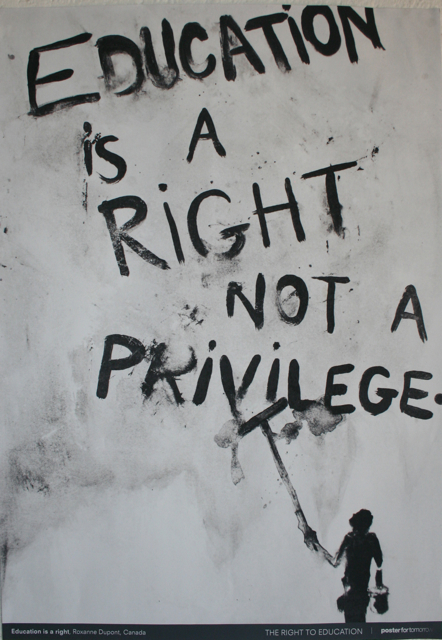Lawsuit Revisits the Question of Education As a Fundamental Right Under the U.S. Constitution, But Is There More To It Than That?

Plaintiffs in Connecticut have filed a new lawsuit against the state challenging the "inexcusable educational inequity and inadequacy" in its school "that prevent inner-city students from
accessing even minimally acceptable public-school options." The complaint argues that these problems are a result of:
accessing even minimally acceptable public-school options." The complaint argues that these problems are a result of:
First, Connecticut has instituted a moratorium on new magnet schools (Conn.
Gen. Stat. § 10-264l(b)(1); Public Act No. 09-6, § 22 (Spec. Sess.); Public Act No. 15-177, § 1), despite the fact that a large majority of Connecticut’s magnet schools consistently outperform inner-city traditional district schools.
Gen. Stat. § 10-264l(b)(1); Public Act No. 09-6, § 22 (Spec. Sess.); Public Act No. 15-177, § 1), despite the fact that a large majority of Connecticut’s magnet schools consistently outperform inner-city traditional district schools.
Second, Connecticut’s arcane and dysfunctional laws governing public charter
schools (Conn. Gen. Stat. §§ 10-66ee(c)-(d), 10-66bb(a), 10-66bb(g)) prevent high-performing charter schools from opening or expanding in the State, despite the fact that Connecticut’s few charter schools consistently outperform inner-city traditional district schools.
schools (Conn. Gen. Stat. §§ 10-66ee(c)-(d), 10-66bb(a), 10-66bb(g)) prevent high-performing charter schools from opening or expanding in the State, despite the fact that Connecticut’s few charter schools consistently outperform inner-city traditional district schools.
Third, Connecticut’s inter-district Open Choice enrollment program (Conn. Gen.
Stat. §§ 10-266aa(c), 10-266aa(e), 10-266aa(f), 10-266aa(g), 10-266aa(h)) penalizes school districts that accept students from inner-city school districts, thus dooming the viability of the very program ostensibly designed to provide Connecticut’s students with quality public-school options.
Stat. §§ 10-266aa(c), 10-266aa(e), 10-266aa(f), 10-266aa(g), 10-266aa(h)) penalizes school districts that accept students from inner-city school districts, thus dooming the viability of the very program ostensibly designed to provide Connecticut’s students with quality public-school options.
As a remedy, plaintiffs ask:
for a simple declaration that would have immeasurable benefits for many thousands of children: By forcing Plaintiffs and thousands of other students to attend public schools that it knows are failing, while impeding the availability of viable public educational alternatives through the Anti-Opportunity Laws, Connecticut is violating students’ federal due process and equal protection rights. Connecticut should be required to take any and all steps necessary to ensure that neither Plaintiffs nor any other students within its borders are forced to attend a failing public school.
The case is a hard one to pigeonhole. On the one hand, it attempts what I and others have long advocated for: a reconsideration and overturn of San Antonio v. Rodriguez. As the Connecticut Mirror reports,
Forty-three years have passed since the U.S. Supreme Court narrowly ruled in the landmark San Antonio v. Rodriguez school-funding case that education was not a constitutional right and that the disparate spending on education for students from low-income neighborhoods was not a violation of the equal protection clause of the U.S. Constitution.
"The time has come for the federal courts to recognize a federal constitutional right to some minimal, adequate level of education. We felt Connecticut was a very good place to bring it," said Theodore J. Boutrous, one of the attorneys representing the seven student plaintiffs from low-income families.
Boutrous told reporters during a Wednesday conference call that the Rodriguez decision "left open the possibility that a claim like ours could succeed" since that case focused on school funding disparities while this lawsuit focuses on the limited options students have to leave failing schools.
. . .
Experts observing this case say a lot is at stake.
On the other hand, the case takes a factual angle in making out this claim that sounds a lot like free market thinking in education. Moreover, Students Matter, the group that has lead the constitutional challenge to teacher tenure, is backing the case. As a factual matter, the case would appear to be about student choice. It holds up the interdistrict magnet schools created as a result of the Sheff v. O'Neill litigation, which are designed to further integration, as important models for improving educational opportunities for minority student, but argues those type of magnets are not the only viable option. More charter schools, it argues, could create similar options to escape currently unconstitutional traditional public schools. In this respect, the plaintiffs are trying to, in effect, piggy back off of the success of Sheff.
My initial response is that there is a big gaping hole in this use of Sheff magnets. Sheff magnets are an integrative cure to a segregative injury. It is not clear that charters are a proportional or analogous remedy to anything, nor Education Law Prof Blog:
